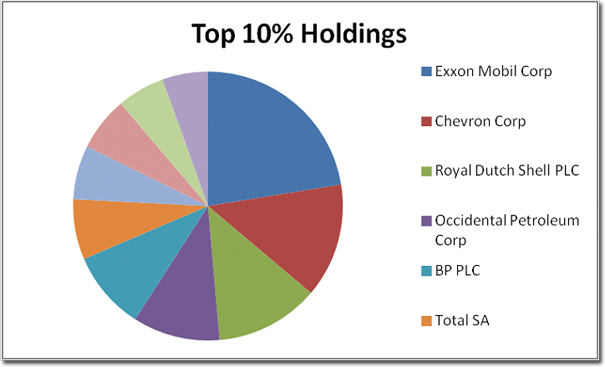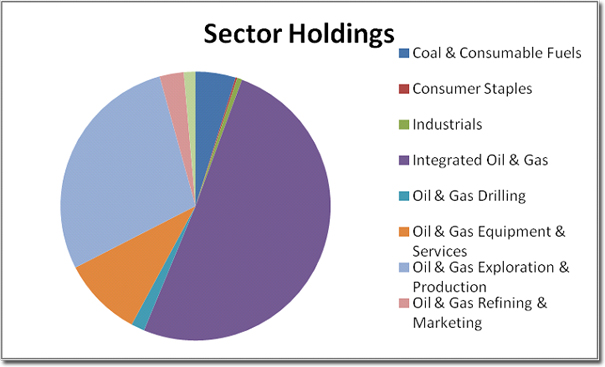 Last week we examined a set of mutual funds that delivered stability and safety for an investor looking to pursue a somewhat more aggressive inflation-hedged bond portfolio.
Last week we examined a set of mutual funds that delivered stability and safety for an investor looking to pursue a somewhat more aggressive inflation-hedged bond portfolio.
In order to both provide some contrast, as well as to examine the lucrative oil markets of the last ten years, I’ll be digging into some more aggressive funds this week. Specifically, I’ll be summarizing the performance and holding of Vanguard’s Specialized Energy Fund (VGENX) against some comparative market benchmarks. Once we have an understanding of what makes these funds tick, I’ll proceed to describe how it is that a personal investor can evaluate these funds against each other, in order to discover the best potential fit for their portfolio.
Objective & Strategy
Vanguard’s objective for this fund is to pursue long-term capital appreciation by investing in the equity securities of companies engaged in energy related activities. In investor-speak, this translates to mean that the company pursues fairly risky capital gains from companies in the global oil and gas industry. These returns are then compared against the S&P Energy Sector Index.
Comparative Performance & Benchmarking

When examining these returns, it is immediately obvious how the fund has managed to outperform its explicit index. However, when comparing it against a competing fund, it is not immediately apparent that it may be an overtly superior fund.
Distributions

Capital Gains

Capital Requirements & Fees
The Vanguard Energy Fund maintains a minimum capital requirement of $3,000, with incremental minimums of $100. However, it maintains an extremely low Management Expense Ratio of .34%, as opposed to an advertised industry average of 1.62%. The comparable Fidelity fund maintains a ratio of .85%. In addition, the fund assesses a 1% on the sale of units held for less than one year, making it somewhat of a closed-end fund. Lastly, the fund charges a $20 annual account service fee for all funds held with a balance of less than $10,000. This fee goes towards providing account statements and information, and is waived if the investor chooses to handle their investments directly through vanguard.com.
Risk Metrics
From a risk perspective, the fund itself is showing a standard deviation of $3.64 (5.6%) against its current YTD performance. Unfortunately, the exposure of this fund to macroeconomics results in standard deviation serving as a fairly poor risk metric. However, the overall composition of the fund provides valuable information about how the company is managing its situation.
Specifically, the fund is holding no more than 9% of a single company (this top holding being Exxon Mobil Corp), and has more than 150 holdings in its portfolio. While the top ten holdings of this portfolio still make up 40% of the total holdings, it has still managed to diversify 31% of its holdings to being international.
From a valuation perspective, the P/E ratio is at a fairly reasonable 12.7x, while the P/B ratio is at a somewhat more expensive 1.7x, suggesting that the fund is priced as a long term holding. Lastly, it is important to note that the hold is only holding 2% of its NAV as short-term reserve capital. While this is encouraging in the way that it demonstrates the fund’s commitment to aggressively pursuing opportunities, it places a great deal of risk on the table, as the company would need to liquidate holdings if investors decided to start pulling out. This may become an issue, as the performance of the fund has been recently decreasing by 3.8%/year.
Holdings


This fund maintains a great deal of exposure to the Oil and Gas industry as a whole, favouring integrated companies that can create the greatest amount of gains throughout the entire value chain of the industry. The company also allocates a great deal of its holdings to risky drilling companies with large pay-out potential. While the fund makes no secret about its desire to be exposed to the industry risks of the energy sector, its diversification provides a great deal of strategic for an investor, in the way that it slightly softens its exposure to the company-specific volatility that shakes small portfolios.
Having taken the time to dig into specifically what it is that this fund has to offer as an investment opportunity, the next article will go into detail about why we’d specifically be interested in holding it in a personal portfolio.



